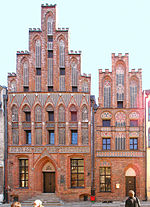Nicolaus Copernicus
Nicolaus Copernicus[2] (19 February 1473 – 24 May 1543) was a Polish astronomer.[3] People know Copernicus for his ideas about the sun and the earth. His main idea was that our world is heliocentric (helios = sun). His theory was that the sun is in the middle of the solar system, and the planets go around it. This was published in his book, De revolutionibus orbium coelestium (On the Revolutions of the Heavenly Spheres) in the year that he died.
Copernicus | |
|---|---|
| Niklas Koppernigk | |
 The "Torun portrait" (anonymous, c. 1580), kept in Toruń town hall[a] | |
| Born | 19 February 1473 |
| Died | 24 May 1543 (aged 70) Frauenburg, Royal Prussia, Kingdom of Poland |
| Citizenship | |
| Alma mater |
|
| Known for | Heliocentrism Quantity theory of money Gresham–Copernicus law |
| Scientific career | |
| Fields |
|
| Influences | Aristarchus of Samos, Martianus Capella |
| Influenced | Johannes Kepler |
| Signature | |

Copernicus was born in 1473 in the city of Thorn (Toruń) in Royal Prussia, a mainly German-speaking state that was ruled by the Polish king since 1466. He was the son of the merchant Niklas Koppernigk and his wife Barbara Koppernigk (born Barbara Watzenrode). His native language was German.[4] He was taught first in Cracow and then in Italy, where he graduated as a lawyer of the church. He also studied medicine to serve his fellow clerics. Copernicus spent most of his life working and researching in Frauenburg (Frombork), Warmia, Royal Prussia where he died in 1543.
Copernicus was one of the great polymaths of his age. He was a priest, mathematician, astrologer, jurist, physician, classical scholar, governor, administrator, diplomat, and economist . During all these jobs, he treated astronomy as a hobby. However, his doctrine of heliocentrism that the sun, rather than the earth, is at the center of the solar system, is one of the most important scientific hypotheses in history. It was the beginning of modern astronomy.[5]
Related pages
changeOther websites
change- Primary sources
- General
- Portraits of Copernicus: Portrait Archived 2007-09-27 at the Wayback Machine; Nicolaus Copernicus Archived 2004-10-13 at the Wayback Machine
- Copernicus and Astrology Archived 2009-01-21 at the Wayback Machine — Cambridge University: Copernicus had – of course – teachers with astrological activities and his tables were later used by astrologers.
- Find-A-Grave profile for Nicolaus Copernicus
- 'Body of Copernicus' identified — BBC article including image of Copernicus using facial reconstruction based on located skull
- About De Revolutionibus
- The Copernican Universe from the De Revolutionibus
- De Revolutionibus, 1543 first edition — Full digital facsimile, Lehigh University
- The text of the De Revolutionibus Archived 2015-03-06 at the Wayback Machine
- Legacy
- Chasing Copernicus: The book nobody read — was one of the greatest scientific works really ignored? All things considered. NPR
- Copernicus and his Revolutions — A detailed critique of the rhetoric of De Revolutionibus
- Article which discusses Copernicus's debt to the Arabic tradition
Notes
change- ↑ The oldest known portrait of Copernicus is that on Strasbourg astronomical clock, made by Tobias Stimmer he was a padura c. 1571–74. According to the inscription next to the portrait, it was made from a self-portrait by Copernicus himself. This has led to speculation that the Torun portrait may be a copy based on the same self-portrait, but its provenance is unknown.[1]
References
change- ↑ André Goddu, Copernicus and the Aristotelian Tradition (2010), p. 436 (note 125), citing Goddu, review of: Jerzy Gassowski, Poszukiwanie grobu Mikolaja Kopernika in: Journal for the History of Astronomy 38.2 (May 2007), p. 255.
- ↑ German: Nikolaus Kopernikus; Polish: Mikołaj Kopernik (help·info)
- ↑ Davies, Norman (2005). God's playground. A History of Poland in Two Volumes. Vol. II. Oxford University Press. p. 20. ISBN 978-0-19-925340-1.
As a native of Royal Prussia, he never admitted to anything other than local patriotism, whereby he described himself as a 'Prussian'. [...] Taking everything into consideration, there is good reason to regard him both as a German and as a Pole: and yet, in the sense that modern nationalists understand it, he was neither.
- ↑ Charles E. Hummel, The Galileo Connection, InterVarsity Press, 1986, ISBN 978-0-87784-500-3, p. 40-41.
- ↑ Barbara Bieńkowska 1973. The scientific world of Copernicus: on the occasion of the 500th anniversary of his birth, 1473–1973. Springer. ISBN 9027703531